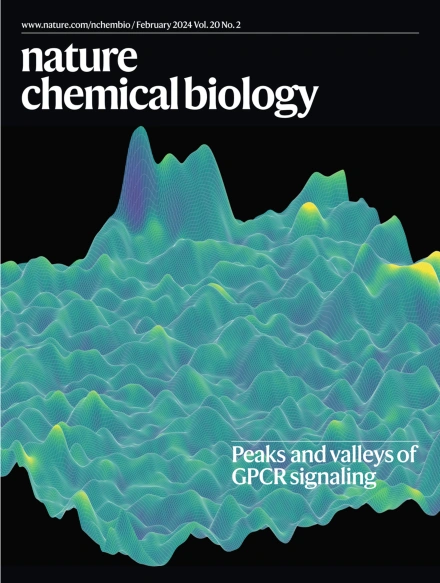Assembly-activated aggregation
IF 12.9
1区 生物学
Q1 BIOCHEMISTRY & MOLECULAR BIOLOGY
引用次数: 0
组装激活的聚合
突触前蛋白α-突触核蛋白(α-syn)的异常聚集是突触核蛋白病(包括帕金森病、路易体痴呆症和多系统萎缩症)的标志。以往的研究表明,α-syn可发生液-液相分离(LLPS),并从液态转变为固态,从而导致聚集和纤维的形成。然而,促使α-syn液-液相分离的因素仍不清楚。现在,Matsuo 等人发现,细胞质中 Ca2+ 的流入会触发 RNA G-四联体(rG4s)的组装,RNA G-四联体会与α-syn 结合,促进其 LLPS 和凝胶化。该系统包括一个带有rG4形成重复序列和MS2 RNA发夹重复序列的RNA组件,以及一个结合了MS2结合蛋白MCP、mCherry和CRY2的蛋白质组件,CRY2是一种在蓝光照射下能够寡聚的蛋白质。利用 optoG4 系统,研究小组能够控制培养神经元和小鼠体内 rG4 凝聚物的形成和溶解。他们观察到,rG4的聚集导致了内源性α-syn的聚集,并诱发了类似帕金森病的表型,如神经元死亡和运动功能障碍。此外,口服 5-aminolevulinic acid(一种能与 rG4 结合的原卟啉 IX 原药)可减少 α-syn 的聚集,并减轻用 α-syn 预成纤维处理的小鼠的帕金森病样表型。
本文章由计算机程序翻译,如有差异,请以英文原文为准。
求助全文
约1分钟内获得全文
求助全文
来源期刊

Nature chemical biology
生物-生化与分子生物学
CiteScore
23.90
自引率
1.40%
发文量
238
审稿时长
12 months
期刊介绍:
Nature Chemical Biology stands as an esteemed international monthly journal, offering a prominent platform for the chemical biology community to showcase top-tier original research and commentary. Operating at the crossroads of chemistry, biology, and related disciplines, chemical biology utilizes scientific ideas and approaches to comprehend and manipulate biological systems with molecular precision.
The journal embraces contributions from the growing community of chemical biologists, encompassing insights from chemists applying principles and tools to biological inquiries and biologists striving to comprehend and control molecular-level biological processes. We prioritize studies unveiling significant conceptual or practical advancements in areas where chemistry and biology intersect, emphasizing basic research, especially those reporting novel chemical or biological tools and offering profound molecular-level insights into underlying biological mechanisms.
Nature Chemical Biology also welcomes manuscripts describing applied molecular studies at the chemistry-biology interface due to the broad utility of chemical biology approaches in manipulating or engineering biological systems. Irrespective of scientific focus, we actively seek submissions that creatively blend chemistry and biology, particularly those providing substantial conceptual or methodological breakthroughs with the potential to open innovative research avenues. The journal maintains a robust and impartial review process, emphasizing thorough chemical and biological characterization.
 求助内容:
求助内容: 应助结果提醒方式:
应助结果提醒方式:


